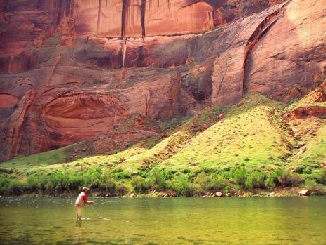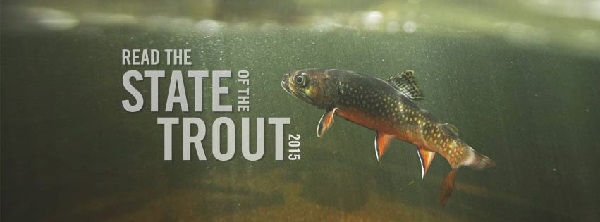 Back in the 1970s, the 15-mile stretch below Glen Canyon Dam on the Colorado River known as Lees Ferry was renowned as one of the finest tailwater fisheries in the world. Anglers flocked there to catch monster rainbows fattened on Gammarus scuds to the 10- to 20-pound range amid cold, clear river flows and spectacular desert canyon scenery.
Back in the 1970s, the 15-mile stretch below Glen Canyon Dam on the Colorado River known as Lees Ferry was renowned as one of the finest tailwater fisheries in the world. Anglers flocked there to catch monster rainbows fattened on Gammarus scuds to the 10- to 20-pound range amid cold, clear river flows and spectacular desert canyon scenery.
The fishery has experienced ups and downs over the years. Today, the Lees Ferry trout fishery, while still good, is a shadow of its former self. Arizona Trout Unlimited and other partners would like to bring the fishery back to some semblance of its glory days.
Joe Miller of TU’s Arizona Council says managing flows from Glen Canyon dam is a key. “The Lees Ferry fishery has so much more potential than we’re realizing now,” he told me, “But we need to fine-tune the dam releases to find more sustainable and optimal conditions for the trout.”
The massive dam, completed in 1964, helped create a recreational coldwater fishery in a desert environment. But managing those flows over the years has proved tricky. Water releases and temperatures impact everything from the survival of juvenile trout to aquatic bug and food production.
In recent years, dam operations have led to a decline in bug life on the river and water conditions that fall short of a quality trout fishery. Gammarus scuds are greatly reduced, and main food base is now only midges and very small black flies. Several of the most common bug orders found in every other quality tailwater fishery in the West—mayflies, stoneflies and caddis flies—are totally absent from the Lees Ferry trout buffet.
Moreover, frequent High Flow Events (HFE’s) in the fall may be adversely impacting the rainbow trout fishery and the aquatic food base.
For the last 5 years, the Bureau of Reclamation, the dam operators, and the National Park Service have been developing the Glen Canyon Dam Long Term Experimental and Management Plan EIS (LTEMPEIS), which will determine how the Glen Canyon Dam operates for the next 20 years.

It’s a prime opportunity for anglers to have a direct say in how fishery is managed—but public comments for the EIS are due by May 9.
Some of the key LTEMPEIS recommendations from TU and other groups include:
- recognize the Lees Ferry rainbow trout fishery as a priority resource “value” to be enhanced by dam operations.
- test the use of sustained low and steady flows to increase the production and diversity of the aquatic insects in the Colorado River below Glen Canyon Dam.
- modify the HFE protocol to shift more high flows from the fall to the spring to benefit a variety of resources besides sediment/sandbars, including aquatic food base and the rainbow trout fishery. HFE’s should only be conducted in the spring if/when the condition of trout or the aquatic food base in Lees Ferry is poor.
- reintroduce historic mayfly, caddis and stonefly species in the Lees Ferry reach.
These and other science-based recommendations (read the full report here) are supported by a wide range of conservation organizations and outfitters and guides, including Trout Unlimited and its Arizona Council and chapters, International Federation of Fly Fishers, Theodore Roosevelt Conservation Partnership, Arizona Wildlife Federation, Arizona Fly Casters, Desert Fly Casters, Orvis Company, Lees Ferry Anglers, Marble Canyon Outfitters and many more. The Arizona Department of Fish and Game has issued a formal Lees Ferry Fisheries Management Plan based on those recommendations.
It’s time to get Lees Ferry back on track – go to the TU Action Alert and express your support for trout-friendly dam operations and aquatic habitat restoration at Lees Ferry.
And please comment before May 9, 2016!
If we miss this opportunity, it could be decades before we get another shot at restoring Lees Ferry to its glory days.
By Randy Scholfield
Randy Scholfield is TU’s communications director for the Southwest region.
